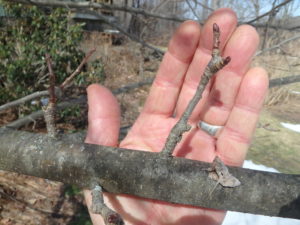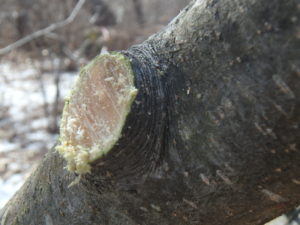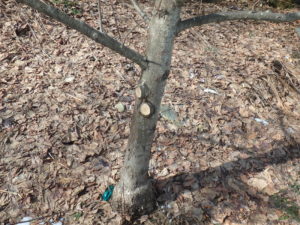A Late Fall Garden Chore: Pruning
Pruning Fruit Trees
A well pruned apple tree in full bloom or loaded with fruit is a feast for the eyes. Now is a good time to work on your trees – though you can prune in any month without damaging your tree. Farmers of yesteryear pruned their fruit trees in March, probably because there was no planting and weeding to do. Most orchardists stop pruning when the flowers open in May because working in the tree then will knock off potential fruit.
Before pruning a tree I walk around it a few times, looking at it carefully to determine its basic nature. What shape is it genetically programmed to be? Some trees want to grow lean and tall (particularly pears), others want to develop a thick, dense canopy, and a few seem to like an open, somewhat sparse canopy. Some send up many vertical water sprouts every year, others few. But you can sculpt your tree to be almost anything you want – within reason.
I do insist on a clear trunk up at least 3 or 4 feet from the ground, or even more. This allows me to get to the trunk of the tree to pick fruit, to prune or to mow beneath it. Ideally, low branches are cut off when a tree is small. But if not, start there this year.
Where you make your pruning cut is important for tree health. Don’t cut branches flush to the trunk or a bigger branch. Don’t cut into the swollen area at the base of a branch, an area called the “branch collar”. You can often see a distinct edge to the collar where the wrinkles in the bark in the branch collar stop and smooth bark of the branch begins. But don’t cut off branches too far from the trunk, either. That creates stubs that will die and slowly rot away – leaving an open wound where disease can enter.
Cutting a large branch requires 3 cuts to avoid tearing the bark of the trunk: first, go out the branch a foot or more, and make an undercut. Cut a third of the way through the branch from below. Then move your saw a little farther out the branch and cut down, from the top. Cut right through.
A heavy branch will probably start to drop when you are about half way through the second cut, and the bark will begin to rip. But the undercut will stop the rip, and allow the heavy branch to fall to the ground. Then you can make your third cut near the branch collar.
Remember this: it’s always better to take a few larger branches than 50 smaller ones. And it’s less work, too. Don’t nibble away at your tree like a deer. Be decisive. In any given year you can remove up to 20% to 25% of the (potential) leaves on a tree. Take all dead branches, too, they don’t count. If you rub a branch with your fingernail and you expose a green layer, the branch is alive.
Pruning saws have changed and improved over the years. The bow saw I used as a Boy Scout is outmoded. Tri-cut saws, even relatively small folding saws, are sharp and able to go through wood like termites on speed. Never use a dull or rusty saw. The same goes for your pruners and loppers. Bypass pruners (which work like scissors) are better than anvil-type pruners, which crush branches.
Your goal in pruning is to open up the tree, allowing sunshine to reach every leaf and to allow breezes to promote drying of leaves after a rain or heavy dew. Most fungal diseases thrive when leaves and fruit are constantly wet.
So what to remove? If 2 branches are touching, remove one. If one branch is directly over another, shading it, remove one or the other. Your choice. I look for fruit spurs when deciding which to remove. Fruit spurs are from an inch to 5 inches long and terminate in one or more fat buds. They will open up to multiple flowers and leaves.
I also remove the “dumb branches” – those that instead of reaching out and grabbing sunshine are headed back into the interior of the tree. Not sure why they do that, but they’ve got to go. Darwin would approve.
Not sure if you should remove a branch? Ask yourself what the branch will be like in 5 years, or 10. If it’s going to crash into another branch in a few years, take it out now. And after you’ve removed a big branch, never have second thoughts. In no time others will grow to fill the gap.
For me, pruning is not just about getting the most flowers or fruit from a tree, it’s about creating a beautiful form. In winter, especially, I enjoy looking at a well-pruned tree as sculpture. I prune professionally and love to restore old apple trees. And even though I’m 70 years old, I love to climb to the top of old apple trees, communing with Mother Nature and taking time to enjoy the beauty she has created. I hope I get to keep on climbing trees until the very end of my days.
Read my twice-weekly blog at https://dailyuv.com/





